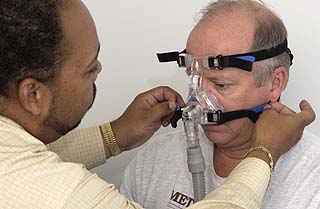
Surveys
Awards
DJC.COM
March 25, 2004
Sleep and safety make sound partners
Swedish Medical Center

Photo courtesy of Swedish Medical Center
A technician fits a Continuous Positive Air Pressure device, which is often prescribed to sleep apnea patients to ensure they do not stop breathing during sleep.
|
Why should any company worry about how well its construction and transport crews sleep? For many more reasons than you might think. As a recent BusinessWeek article pointed out: “Lack of sleep makes people clumsy, unhappy, stupid and dead.”
Sound sleep is vital to good health and to peak performance in any line of work. Yet, according to the National Sleep Foundation, most Americans don't get the optimal eight hours of shuteye each day. In fact, 40 percent of people surveyed recently say they experience disruptive on-the-job sleepiness at least a few days every month.
Anyone who's ever worked construction knows it's often both physically and mentally demanding. Lifting heavy tools and materials, the constant motion of equipment, fatigue from noise and stress, elevated temperatures and other factors can all lead to weary workers. Add to that insufficient sleep — and maybe an undiagnosed sleep disorder — and you have the recipe for a possible workplace disaster.
Sleepiness breeds inattentiveness and that can lead directly to costly construction mistakes and, worse yet, to industrial accidents. Also, employee time loss can be increased because insufficient sleep often aggravates pre-existing conditions such as lower-back injury and pain.
Here are a few common concerns about sleep and construction work.
Often undiagnosed, apnea is a potentially life-threatening breathing condition affecting up to 20 million Americans. In addition to disrupting sleep, it is clearly associated with an increased rate of heart attack and stroke. Typical apnea symptoms include falling asleep while working or driving, early morning headaches, learning and memory difficulties, depression and irritability — all of which impair performance.
| How to get a good sleep |
Most people only need to make a few simple changes in their lifestyles to improve sleep-related health.
|
If a worker is obviously drowsy, encourage him or her to stop work as soon as safely possible. Crew leads should quickly grant requests for a break or brief nap, and make caffeinated beverages available to help increase alertness. Caffeine, of course, is no long-term substitute for adequate sleep.
Many smaller-scale residential contractors have it even worse. Their days start very early on the jobsite and end with the late-night paperwork, purchasing, sales, payroll and billing. During the height of the building season, it's not uncommon for homebuilders to work dawn to dusk, six days a week.
If you or employees regularly pull more than one shift, don't try to sustain that for very long. And, if you rotate crew shifts frequently, make sure they progress forward from day to swing to night — or you risk upsetting the body's Circadian rhythm. Also, encourage swing- and night-shift workers to keep the same wake/sleep cycle on their days off.
In one recent high-profile case, a young construction supervisor's employer had huge financial pressures to get a manufacturing plant retrofitted and back online. After working 20 hours straight for several days in a row, the supervisor fell asleep on the way home and drove off the road. He suffered a serious head injury in the crash and was permanently disabled. In the civil litigation that followed, the young man's wife provided compelling testimony that her husband felt he simply couldn't say no to his employer.
For free copies of workplace posters and flyers on sleep health, contact the Swedish Sleep Medicine Institute at (206) 215-3899.
Dr. Ralph Pascualy is medical director of the Sleep Medicine Institute at Swedish Medical Center in Seattle.
Other Stories:
- Spiking costs shadow construction market
- Beware of vulnerabilities during construction
- Construction industry struggles to accept ISD
- The roots of Washington's new building code
- Government takes a shine to alternative bids
- New laws have yet to stem tide of condo suits
- WSU students train for the Solar Decathlon
- An ACE in the hole for high schoolers
- Do you know who your successor is?
- Six ways to keep your customers happy
- How ergonomics can fatten the bottom line
- More training needed for crane operators
- Shattering the myth of wired glass
- Want big profits? Make yours a high-trust company
- Equipment costs don't have to break the bank
- Listen up workers: act quickly on hearing loss
- In a lawsuit? Who's paying the lawyers?
Copyright ©2009 Seattle Daily Journal and DJC.COM.
Comments? Questions? Contact us.